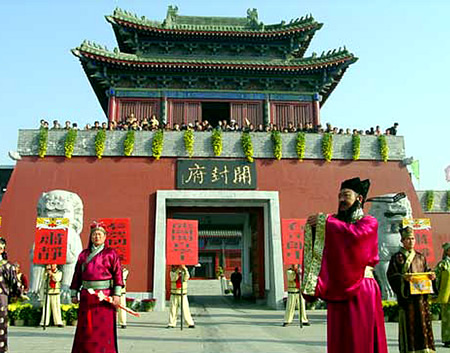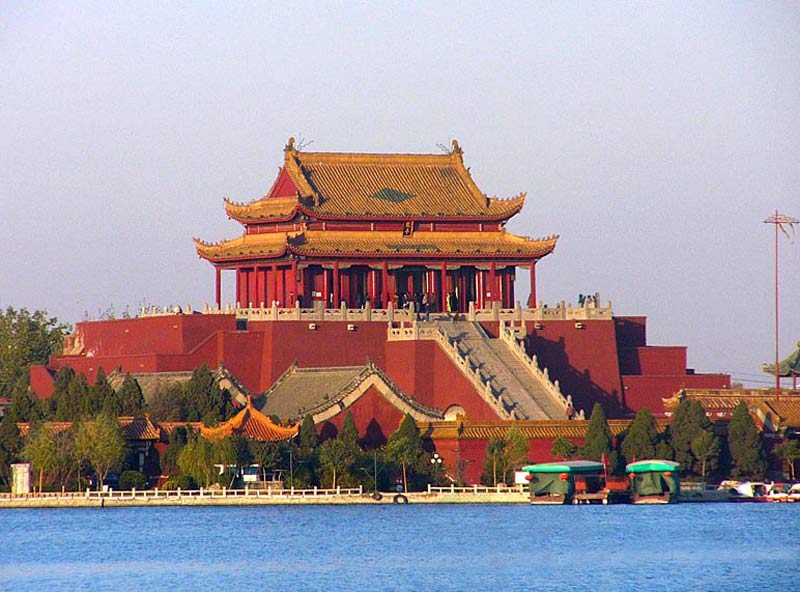 |
| Kaifeng gate |
Kaifeng became the capital city of the Northern Song (Sung) dynasty c. 960–1126, when it was also called Bian (Pien) and was located south of the Yellow River on a rich agricultural plain in modern Henan (Honan) Province. Kaifeng was close to the Grand Canal, which made the wealth of the south easily accessible.
The down side to its location was that it had no natural defenses and had to rely solely on massive city walls for protection. Kaifeng was wealthy and cultured, with a population of around a million people. It had China’s oldest synagogue and Jewish community, immigrants from Persia, whose descendants survived as a distinct group until modern times.
The Song dynasty was never militarily powerful; it lacked good horses for its cavalry and was surrounded by strong and hostile neighbors. One was the nomadic Khitan from Manchuria who ruled northeastern China as the Liao dynasty, with a capital city at modern Beijing. After defeating it in war the Liao extracted heavy tribute from the Song as condition for peace.
 |
In time the Liao were threatened by new nomads from farther north called the Jurchen, who established the Jin (Chin) dynasty. In 1118 the Song formed an alliance with the Jin and they jointly attacked and destroyed the Liao. Soon the Song-Jin alliance collapsed over the division of spoils. Jin forces then besieged Kaifeng, until famine forced it to capitulate in 1126.
Song was forced to cede territory, pay an immense indemnity, and agree to other onerous terms; then the Jin army withdrew. When Song could not pay its indemnity, Jin attacked again, this time thoroughly pillaging Kaifeng and carrying off Emperor Huizong (Hui-tsung), his heir, and 3,000 men and women of his court to exile in northern Manchuria.
The loot from the government treasury amounted to 54 million bolts of silk, 15 million bolts of brocade, 3 million ingots of gold, and 8 million ingots of silver. Another son of Huizong escaped and eventually established a court in Hangzhou (Hangchow) in southern China; it was called the Southern Song dynasty. Hangzhou soon became the premier city in China.
 |
| Dragon pavilion, Kaifeng, China |
Within a quarter-century the leaders of the Jin dynasty had become so Sinicized that they had abandoned their original capital in northern Manchuria and established two new capitals in the heartland of China, one in modern Beijing, another in rebuilt Kaifeng. In the early 13th century Jin was attacked by the Mongols, the most terrifying conquerors the world had seen.
In 1132 the most powerful Mongol general, Subotai, besieged Kaifeng. The siege was notable in the history of military technology as the first time that gunpowder in grenades and flame throwers was used. After terrible privations Kaifeng surrendered. Subotai demanded the right to destroy the city and massacre its inhabitants.
Fortunately Grand Khan Ogotai Khan was dissuaded from allowing it on the advice of Yelu Chucai (Ye-liu Ch’u-ts’ai), who had himself been a prisoner of the Mongols but had risen to high office under them because of his skills as an astrologer. Yelu calculated that if spared, the people of Kaifeng and surrounding lands could produce more wealth for their Mongol masters. Thus the people of Kaifeng suffered looting and massacre, but most were spared. Kaifeng never became a capital city again.
EmoticonEmoticon